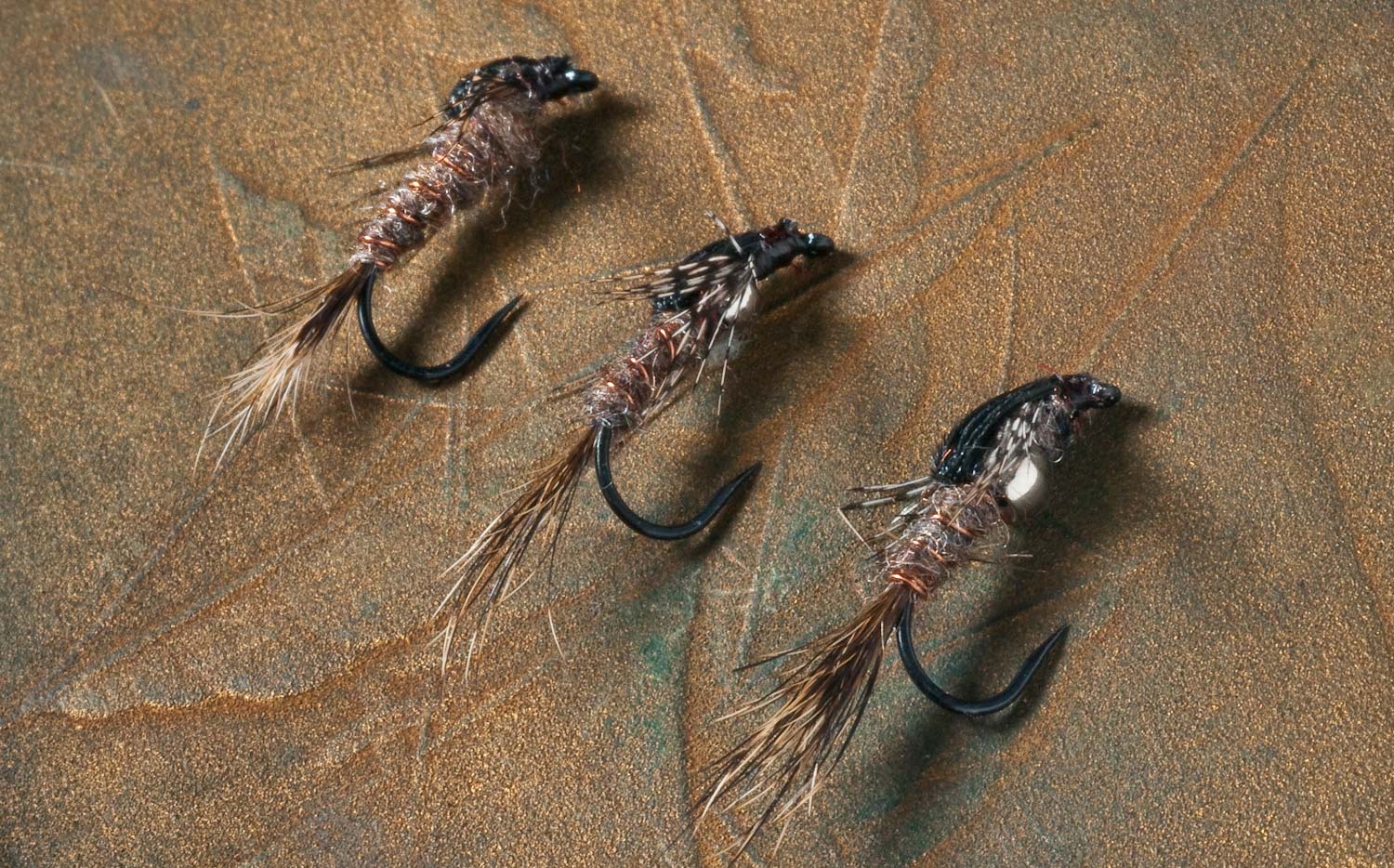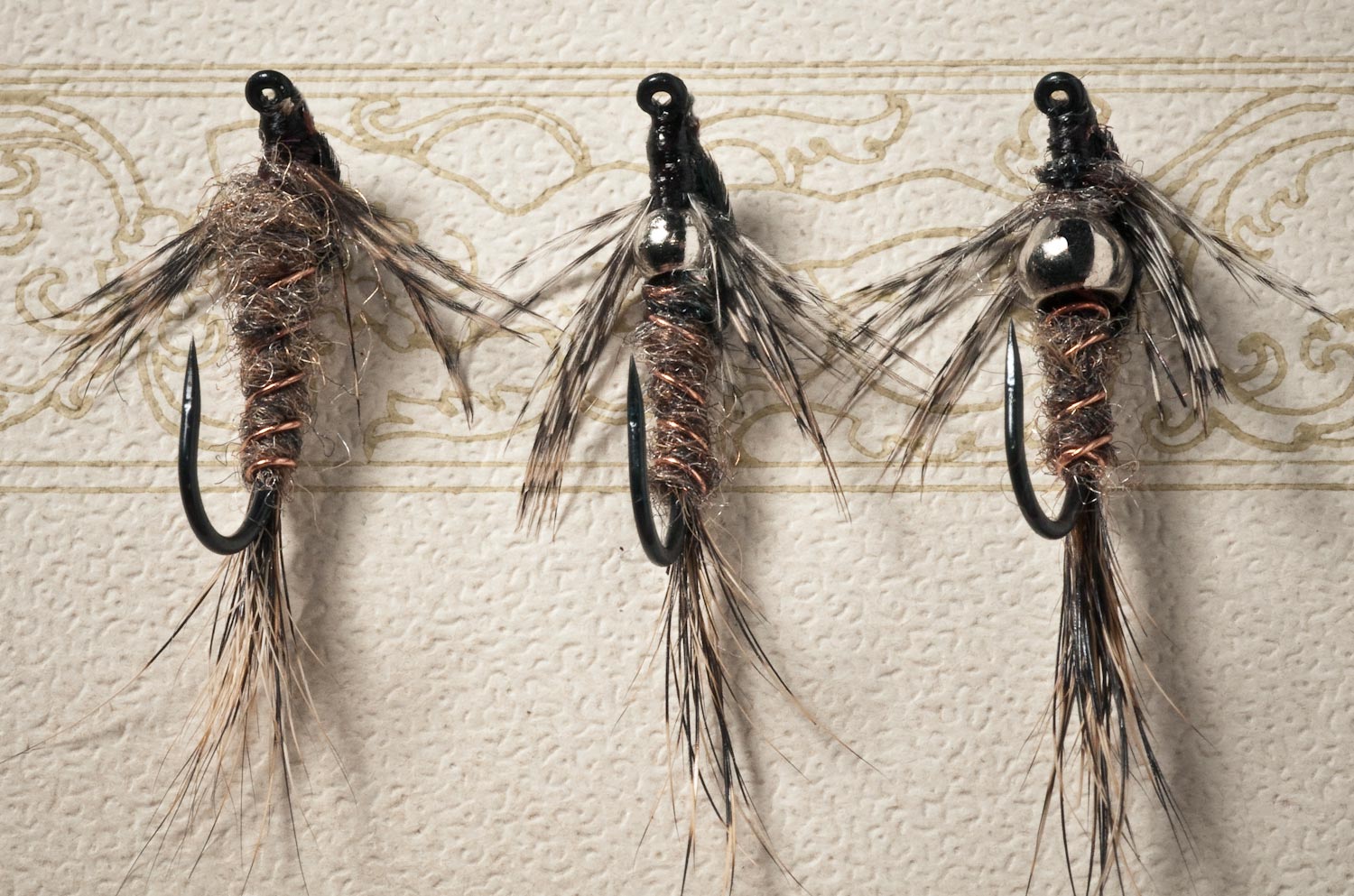This past weekend, on one of my home trout waters, I was freshly reminded how important it can be to carry different weighted versions of my favorite nymph patterns during tough fishing conditions.
The low and gin clear water had the trout extra spooky and cautious. All it took was one wrong move, like my shadow briefly being cast over the water, or a presentation made a little too hard, and the trout ran for their lives like they were being chased by a pack of starving otters.
I use split-shot most of the time with my nymph rigs to get my flies down in the strike zone. It works great for me almost all of the time, but keep in mind that the extra weight added by them, also increases the noise made when presenting your flies on the water. Since I had low and flat water conditions, it wasn’t necessary for me to use them to get my flies down for most of the water anyways, except for the deeper pools. I love my Thingamabobbers but I had to substitute them for small stick-on foam strike indicators to keep my presentations extra quiet. I could have used a dry fly as an indicator but it would have called for me to constantly adjust my dropper length to keep my flies drifting in the preferred depths from one fishing spot to the next.
For the most part, the trout were congregated in the deeper pools, buckets and troughs, where the most water was found, but there were also multiple spots where I found trout holding in shallow, slow moving water located near cover. These places required unweighted or lightly weighted versions of my nymph patterns to get a good drift through the target water. My problem was that the trout were favoring hares ears and I was slap out of unweighted versions of them. My weighted versions worked fine in the deeper water, but they didn’t work so well in the shallow water. I managed to catch a few fish on soft-hackles and pheasant-tails in the shallow water, but I had to really be precise with my presentations to get them to eat. If I would have had more unweighted/lightly weighted hares ears on hand, I’m confident I could have landed more fish in the areas where the trout were holding in shallow water.
For some reason, the trout were willing to move much further to eat a hares ear than my other nymph patterns. I’ve learned over the years, that every fishing day is different and unique. Some days the trout will be opportunistic and will eat a wide selection of fly patterns, while other days, even on water that is so called “infertile”, where there’s low bug densities, trout may choose to go against their opportunistic feeding habits and flat out prefer one food source or fly pattern over the rest. It doesn’t make a lot of since, and it goes against what most fly fishing authors teach, but then again, you alway have to add fishing pressure into the equation. I think this was the case with me this past weekend with the hares ears. For whatever reason, the trout viewed them as being safer to eat. Yet, there’s a good chance, they could have been ignoring the other nymph patterns because they had been seeing them a lot by other fishermen. Lastly, sometimes nymphs without beads can work better than traditional beaded nymphs, for super picky fish. However, you can keep the bead camouflaged by tying them under your materials instead of positioning it at the eye of the hook.
Streams bottoms on trout waters aren’t perfectly flat. They have irregular bottoms that vary in depth. This characteristic was the main problem I had to overcome when trying to drift my nymphs in front of the trout in the shallow water. Since the fish’s senses were extra ampllified from the low water conditions, I was forced to make my presentations to them farther upstream than I normally would, otherwise I would risk spooking them. This generally had me drifting my nymphs at varying depths (1-3 feet) throughout my drift, and the bottom depth often flipped flopped back and forth before my flies finally made it in front of the trout. Nymphs that were too heavy tended to hang up before I could get my flies to the prime lies. If I went short with my indicator setting, my flies would end up drifting too high above the fish. I wished I could have used a czech nymphing approach to control my fly depth better, but the fish wouldn’t allow me to get that close to use this technique. There lies my problem, unweighted or lightly weighted hares ear nymphs were the only thing that allowed me to make the long presentation, keep my flies from snagging up on the bottom and the fish eating. My day’s fishing could have been more successful if I would of had more of these nymphs on hand. I’ve since restocked my fly boxes with different weighted versions of the most popular nymph patterns, and I’ll be ready the next time I head out fly fishing low water conditions.
Tom Rosenbauer, author of The Orvis Guide to Small Stream Fly Fishing, suggests that carrying popular nymphs in different weights is more important than carrying lots of patterns. I concur with him on this notion. Having different weighted versions of your nymphs, allows you to hand pick the correct version for the type of water you’re fly fishing. It also can allow you to avoid using split-shot in some situations, which will make it easier to cast your rig and will cut down on your tangles. The key point is to have the different versions of your fly patterns the same size but weighted differently. This will allow you to match a food source size accurately across the board. Choose unweighted or lightly weighted nymphs for shallow or slow moving water. Medium weighted nymphs for slightly deeper or faster moving water, and use your heaviest nymphs when you’re needing to dredge deep pools or have high and fast water conditions.
Keep it Reel,
Come fish with us in the Bahamas!
Kent Klewein Gink & Gasoline www.ginkandgasoline.com hookups@ginkandgasoline.com Sign Up For Our Weekly Newsletter!


Good solid analysis, Kent. For me, the default is weighted streamers and nymphs with split shot as a last resort. I find it better for casting, stealth, and in most cases presentation. There are exceptions, as when I want the fly to be just a short distance from the bottom. But even then I will try to get that result by dropping an unweighted nymph off a weighted one rather than a split shot.
Of course you and I are fishing the same home water streams. May have something to do with our agreement.
I tie different weights with different thread colors for identification. Hares ears unweighted are black thread.
Hares ear with wire underbody are yellow.
Hares ear with brass bead are black.
Hares ear with brass bead and wire are yellow.
Hares ear with tons of wire and one size up tungsten bead are red.
That’s a pretty handy tip there Dan!!
Easy enough to spot the beads, but that under body wire is a pain to try to ID w/o some other method. Thanks for the idea of using different colors of thread!
That’s a pretty handy tip there Dan!!
Easy enough to spot the beads, but that under body wire is a pain to try to ID w/o some other method. Thanks for the idea of using different colors of thread!
Please do tell about this nymph pattern? Love that hook.